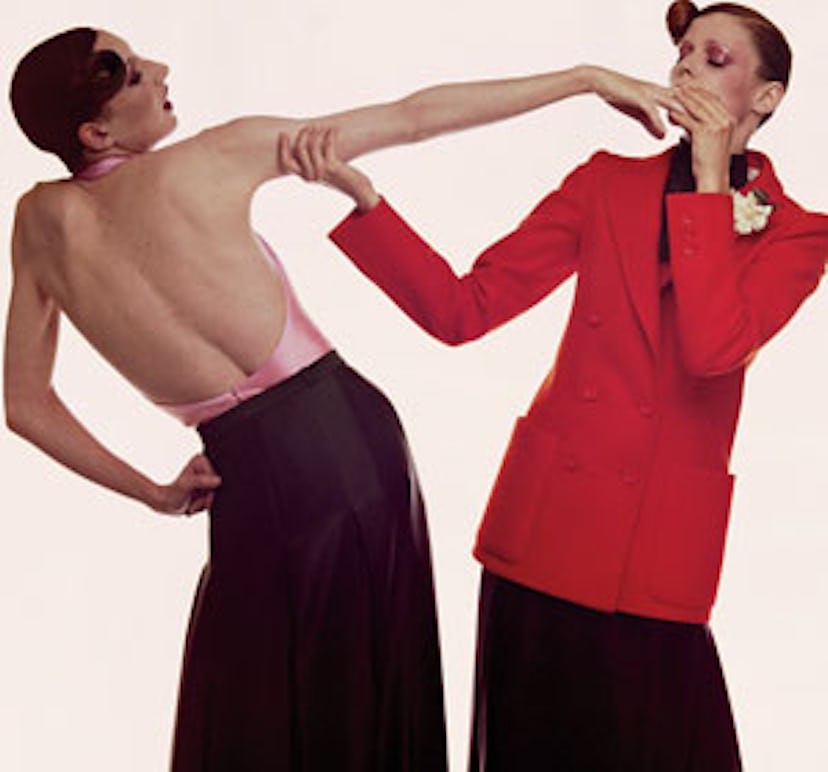I developed my first girl crush—on the illustrator and writer Leanne Shapton—three years ago, when I was working as a Web producer at The New Yorker. A colleague of mine had Leanne’s second book on her desk, and one day I picked it up and slowly started turning the pages, transfixed. The book—Important Artifacts and Personal Property From the Collection of Lenore Doolan and Harold Morris, Including Books, Street Fashion, and Jewelry—is a mock auction catalog that tells the story of a deteriorating relationship through the deacquisitioning of the couple’s possessions. It’s capricious, intelligent, and delicately done.
According to Google and my close interrogation of those who knew her, Leanne appeared to have a most enviable life: She lived in a stunning West Village apartment, all antique rugs and Farrow & Ball paint; wore a Dries Van Noten skirt as effortlessly as she did a painter’s smock; and was happily engaged to the handsome and successful publishing executive James Truman. I adored her from afar, and I suppose a part of me wanted to be her.
A generous friend who knew Leanne found my obsession amusing and arranged for the three of us to have a drink. On the appointed day, I stood in front of my bathroom mirror a cliché of a nervous wreck: rehearsing what to say, fretting over what to wear. Should I go understated and elegant in a black Maria Cornejo dress and Margiela booties? Or maybe something a bit more romantic, like my floral-print Mayle dress with Chanel flats? Should I lead with a handshake? A cheek kiss? A hug? And if she ordered a martini, should I get one, too—or would it be wiser to stick with a glass of Sancerre? More important, why was I treating this like a date?
The “girl crush” may sound silly, but sometimes it takes something unserious to get us talking about a serious subject: the ambitions of young creative women and the need for worthy role models. Among my own nominees for inaugural members of the Girl Crush Hall of Fame are Zadie Smith, with her daring, brilliance, and wild success; Joan Didion, with her cool, spare prose; Patti Smith, with her soul and wisdom; Sofia Coppola, with her chic grace and unmistakable taste; and Tina Fey, with her goofy smile and razor wit. Each of them has accomplished something the rest of us dream of doing. And because they’ve done it, we feel we can too.
There’s a distinctly nineties flavor to the term (think Riot Grrrls), but the idea of the girl crush is much older than that. F. Scott Fitzgerald had something to say on the matter in an essay he penned in 1930: “ ‘Crushes’ were once a boarding-school phenomenon—now any sort of courageous individualism makes a woman the center of a cult…What effect has this woman worship on the young girl herself?”
When my good friend Jenna Wortham—a New York Times reporter—and I decided to start a zine called Girl Crush last spring, we thought of it as a chance to be frivolous, irreverent, and earnest all at once. We created a website, Girlcrushzine.tumblr.com, and began soliciting personal essays. We e-mailed novelist Jennifer Egan, This American Life contributor Starlee Kine, New Yorker writer Amanda Fortini, former Missbehave editor Mary H.K. Choi, and other women we admire.
As varied as the submissions we received were, the answer to Fitzgerald’s question was clear: Woman worship, girl crushing—whatever you want to call it—is a positive trend. Fortini’s took the form of a singular devotion to the journalist Janet Malcolm, whose work she faithfully read and followed when Fortini was an assistant at The New York Review of Books. To Choi, a girl crush is a creatively inspiring friendship born of mutual respect and admiration—like the one she established with the sassy Times columnist Cintra Wilson. For Egan, it represents that moment in girlhood before boys have entered the picture.
After two months, we had dozens and dozens of submissions—more than either of us had anticipated. Had we struck a chord? I can’t help but believe our current generation’s embrace of girl crushing signifies something larger: evidence that a professional world once dominated by men has evened out—maybe not totally, but to a reassuring degree. When Didion first set out to become a writer, she copied the sentences of Ernest Hemingway; today, my friends and I copy hers.
That night, when I arrived at the bar to meet Leanne, I instantly forgot everything I had prepared to say. She asked me about my life. I asked about hers. We slipped into comfortable conversation almost immediately. We talked about books, travel, our hopes and dreams for the year. At the end of the night I walked her home. “Dear Leanne,” I wrote to her the next day, “So fun to meet you last night. I must bashfully admit that my girl crush is undiminished. Hope I played it cool. :)” Over the next year, we gradually moved from being acquaintances to friends. And that’s the thing—a girl crush doesn’t have to be purely aspirational. Still, I’ll never forget what Leanne wrote in response: “Your crush is reciprocated!”
Photo: Copyright Estate of Guy Bourdin. Reproduced by Permission of Art + Commerce
